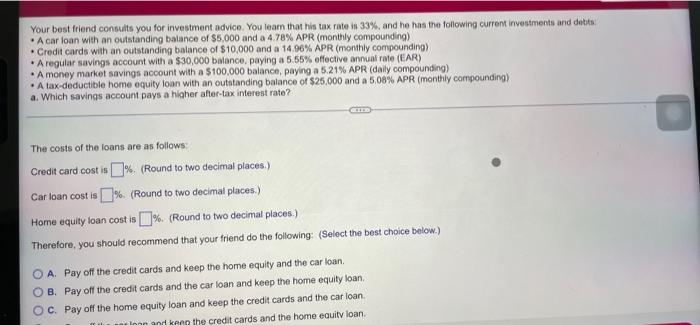Need each and every answer with clear steps please thankyou



Your best friend consults you for investment advice. You learn that his tax rate is 33%, and he has the following current investments and debts; A car loan with an outstanding balance of $5,000 and a 4.78% APR (monthly compounding) Credit cards with an outstanding balance of $10,000 and a 14.96% APR (monthly compounding) A regular savings account with a $30,000 balance, paying a 5.55% effective annual rate (EAR) A money market savings account with a $100,000 balance, paying a 5.21% APR (daily compounding) A tax-deductible home equity loan with an outstanding balance of $25,000 and a 5.08% APR (monthly compounding) a. Which savings account pays a higher after-tax interest rate? b. Should your friend use his savings to pay off any of his outstanding debts? Your best friend consults you for investment advice. You learn that his tax rate is 33%, and he has the following current investments and debts: A car loan with an outstanding balance of $5,000 and a 4.78% APR (monthly compounding) Credit cards with an outstanding balance of $10,000 and a 14.96 % APR (monthly compounding) A regular savings account with a $30,000 balance, paying a 5.55% effective annual rate (EAR) A money market savings account with a $100,000 balance, paying a 5.21% APR (daily compounding) A tax-deductible home equity loan with an outstanding balance of $25,000 and a 5.08% APR (monthly compounding) a. Which savings account pays a higher after-tax interest rate? b. Should your friend use his savings to pay off any of his outstanding debts? a. Which savings account pays a higher after-tax interest rate? (Hint: When calculating the money market return, make sure to carry at least six decimal places in all calculations.) Regular savings pays%. (Round to two decimal places.) Money market account pays%. (Round to two decimal places.) Therefore, the account that pays the most is the (Select from the drop-down menu.) b. Should your friend use his savings to pay off any of his outstanding debts? The costs of the loans are as follows: Credit card cost is%. (Round to two decimal places.) Your best friend consults you for investment advice. You learn that his tax rate is 33%, and he has the following current investments and debits A car loan with an outstanding balance of $5,000 and a 4.78% APR (monthly compounding) Credit cards with an outstanding balance of $10,000 and a 14.96% APR (monthly compounding) A regular savings account with a $30,000 balance, paying a 5.55% effective annual rate (EAR) A money market savings account with a $100,000 balance, paying a 5.21% APR (daily compounding). A tax-deductible home equity loan with an outstanding balance of $25,000 and a 5.08 % APR (monthly compounding). a. Which savings account pays a higher after-tax interest rate?. The costs of the loans are as follows: Credit card cost is%. (Round to two decimal places.) Car loan cost is%. (Round to two decimal places.) Home equity loan cost is %. (Round to two decimal places.) Therefore, you should recommend that your friend do the following: (Select the best choice below.) OA. Pay off the credit cards and keep the home equity and the car loan. OB. Pay off the credit cards and the car loan and keep the home equity loan. OC. Pay off the home equity loan and keep the credit cards and the car loan. loon and keep the credit cards and the home equity loan










